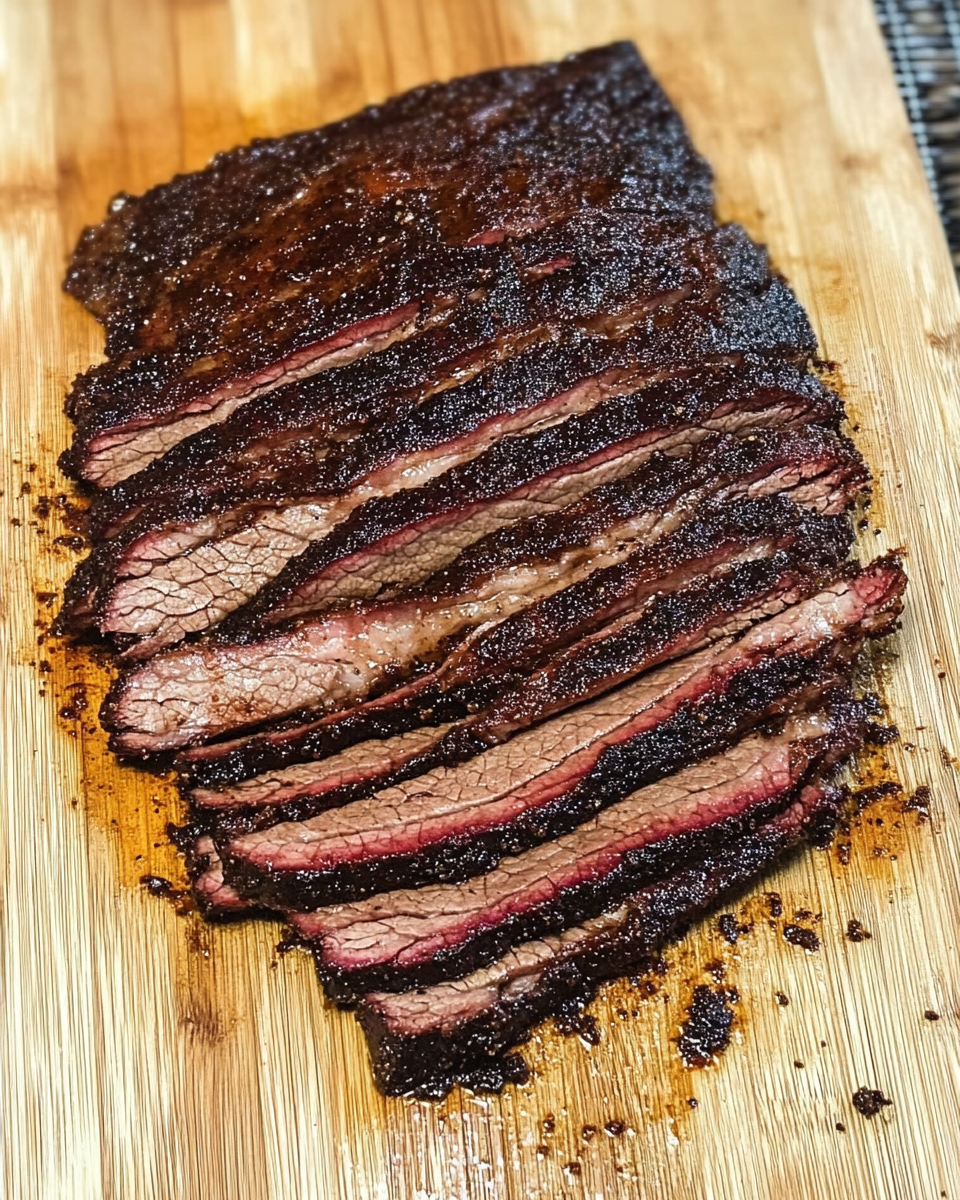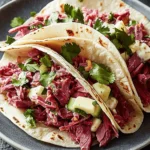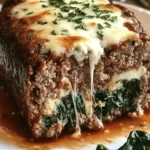Experience the rich flavors of authentic Texas BBQ with this smoked brisket recipe. The combination of a simple yet flavorful dry rub and slow smoking results in a tender, juicy brisket with a perfect bark.
Whether you’re hosting a summer barbecue or preparing a special meal for the holidays, this smoked brisket is sure to impress your guests. Pair it with classic sides like coleslaw, baked beans, or cornbread for a complete meal.
Full Recipe:
Ingredients:
-
1 whole beef brisket (flat or point)
-
2 tablespoons kosher salt
-
2 tablespoons ground black pepper
-
1 tablespoon garlic powder
-
1 tablespoon onion powder
-
1 tablespoon paprika
-
1 tablespoon brown sugar
-
1 tablespoon ground cumin
-
1 tablespoon ground cayenne pepper (optional, for heat)
-
1 cup hickory or oak wood chips (soaked in water for at least 1 hour)
Directions:
-
Prepare the Brisket: Trim excess fat from the brisket, leaving about 1/4-inch layer to protect the meat during smoking.
-
Make the Dry Rub: In a bowl, combine kosher salt, black pepper, garlic powder, onion powder, paprika, brown sugar, cumin, and cayenne pepper.
-
Apply the Rub: Pat the brisket dry with paper towels. Generously coat the brisket with the dry rub, pressing it into the meat. Let it sit at room temperature for 30 minutes.
-
Preheat the Smoker: Preheat your smoker to 225°F (107°C). Add soaked wood chips to the smoker box or directly onto the coals.
-
Smoke the Brisket: Place the brisket fat side up on the smoker grate. Smoke for approximately 1.5 hours per pound, or until the internal temperature reaches 195°F (90°C).
-
Rest the Meat: Remove the brisket from the smoker and wrap it in butcher paper or aluminum foil. Let it rest for at least 30 minutes before slicing.
-
Slice and Serve: Slice the brisket against the grain and serve with your favorite barbecue sides.
Prep Time: 30 minutes | Cooking Time: 6–8 hours | Total Time: 6.5–8.5 hours | Kcal: ~500 kcal per serving | Servings: 6–8
Smoked brisket holds a sacred place in the hearts of barbecue lovers, especially those who appreciate the rich traditions of Texas-style BBQ. This slow-cooked masterpiece is more than just a meal it’s a celebration of flavor, patience, and the timeless craft of smoking meat to tender perfection. Whether you’re a novice griller or an experienced pitmaster, understanding the nuances of smoked brisket can elevate your BBQ skills and delight your guests every time.
Why Brisket? Understanding the Cut
Beef brisket is a cut taken from the lower chest of the cow, a muscle that gets plenty of exercise, making it a tougher cut when raw. However, this toughness is exactly what makes brisket such a fantastic candidate for smoking. When cooked low and slow, the connective tissues in the meat break down, resulting in tender, juicy, and flavorful beef that melts in your mouth.
There are two primary parts to a brisket: the flat and the point. The flat is leaner and easier to slice, making it ideal for sandwiches and presentations. The point is fattier and more marbled, offering a richer, more buttery flavor. Many BBQ enthusiasts prefer to smoke the whole brisket to enjoy the contrast between the two.
The Importance of the Dry Rub
One of the hallmarks of Texas-style brisket is the simple yet potent dry rub. Unlike heavily sauced BBQ styles, Texas BBQ relies on the natural flavor of the meat enhanced by a well-balanced seasoning. The dry rub typically consists of coarse salt and black pepper, sometimes with a hint of garlic powder, onion powder, and paprika to add depth and color.
This minimalist approach allows the smoke flavor and the beef itself to shine. The salt helps form a savory crust, known as the bark, which adds a delicious texture contrast to the tender interior. The pepper adds a mild heat and complexity, essential to the classic Texas BBQ experience.
The Smoking Process: Patience is Key
Smoking a brisket is not a quick process; it’s a labor of love that requires both patience and attention to detail. The ideal smoking temperature is low, generally around 225°F (107°C), which slowly cooks the meat, allowing the collagen in the brisket to break down without drying out the beef.
The choice of wood chips plays a significant role in flavor. Hickory and oak are traditional favorites for Texas-style BBQ, providing a robust, smoky aroma that complements the beef without overpowering it. Some pitmasters experiment with mesquite or fruit woods like apple or cherry to add subtle nuances.
Maintaining a consistent temperature in your smoker is crucial. Fluctuations can affect the cooking time and the texture of the meat. For many, the “stall” a point where the internal temperature seems to plateau can be challenging, but it’s a normal part of the smoking process and signals the meat is slowly becoming tender.
Achieving the Perfect Bark
One of the most coveted features of a smoked brisket is its bark the flavorful, crispy crust that forms on the outside of the meat. The bark results from the Maillard reaction, where the proteins and sugars in the dry rub and meat react to the heat and smoke.
To develop a great bark, avoid wrapping the brisket too early during the smoking process. While wrapping in butcher paper or foil (the “Texas crutch”) helps speed up cooking and retain moisture, it also softens the bark. Many pitmasters prefer to wrap the brisket after a solid bark has formed, striking the perfect balance between tenderness and texture.
Resting: The Final Secret
After hours of smoking, resting the brisket is just as important as the cooking itself. Resting allows the juices, which have been driven to the center by the heat, to redistribute evenly throughout the meat. Without proper resting, slicing can cause those precious juices to spill out, resulting in dry brisket.
Wrapping the brisket in butcher paper or foil and letting it rest for at least 30 minutes, or even up to an hour, gives you a more succulent and flavorful end result.
Serving Suggestions and Pairings
Smoked brisket is wonderfully versatile and can be served in a variety of ways. Thinly sliced brisket on a platter pairs beautifully with classic BBQ sides like creamy coleslaw, tangy pickles, baked beans, and cornbread. For a casual meal, it makes an unbeatable sandwich, especially when paired with pickled onions and BBQ sauce on a soft bun.
For those who enjoy a smoky, hearty meal, adding smoked brisket to chili or tacos can provide an extra layer of flavor. Brisket also works well as a topping for loaded baked potatoes or nachos.
Common Mistakes to Avoid
Even seasoned BBQ enthusiasts can stumble with brisket if they aren’t careful. Here are a few common pitfalls to watch out for:
- Cooking Too Fast: High temperatures may speed up the process but risk drying out the meat.
- Skipping the Rest: Cutting into the brisket too soon will cause the juices to escape.
- Not Trimming Fat Properly: Leaving too much fat can cause flare-ups; trimming it too closely can dry out the meat.
- Under-seasoning: Don’t be shy with the dry rub, as it’s critical for flavor and bark formation.
Why Texas-Style Smoked Brisket Remains a BBQ Classic
Texas-style smoked brisket epitomizes the beauty of simplicity done right. It showcases the flavor of high-quality beef enhanced by seasoning, smoke, and time. Unlike heavily sauced BBQ traditions, Texas brisket is about celebrating the meat itself, making it a favorite for purists and BBQ newcomers alike.
The communal aspect of smoking a brisket — gathering around the smoker for hours, sharing stories and recipes — adds to the cultural significance and joy of this culinary tradition.
Conclusion
Smoked brisket is more than just a dish; it’s an experience rooted in tradition, patience, and respect for quality ingredients. From choosing the right cut of meat and applying the perfect dry rub to mastering the slow-smoking technique, every step contributes to the final masterpiece. The reward? Tender, flavorful, smoky beef with a beautiful bark that will have everyone asking for seconds.
Whether you’re preparing for a backyard barbecue, a holiday feast, or simply craving a hearty meal, this Texas-style smoked brisket recipe delivers authentic flavors that honor the spirit of classic American BBQ. Take your time, follow the process, and enjoy every bite of this smoky, savory delight.






